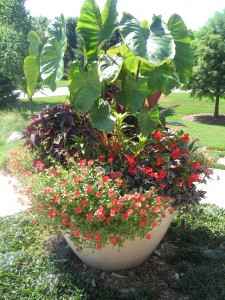Everyone loves color in the landscape, and four season color is a great way to add a punch of pizzazz throughout the year. From in-ground annuals to containers, the options for a creative outdoor display are endless. Color draws people to entrances and serves as a focal point when placed into the garden. When color is used in a business setting, it offers a great deal of enjoyment to customers and employees.
Many people have heard the three part rule to container gardening: thriller, filler, and spiller. The thriller consists of a large element, which is usually placed in the middle of or towards the back of the container. The filler refers to the medium sized plants, which fill the space around the thriller and have an upright habit. The spiller’s job is to do just as its name describes – trail over the side of the container. When planting annual beds, it is important to lay out plants according to their mature sizes and habits.
It is especially important to consider your plants’ environmental needs and to combine plant materials with similar growing requirements. There are several questions which should be asked when selecting plant material. Is the container or bed located in a sunny or shady space? What are the watering requirements? What plant characteristics are you looking for? What are the mature sizes of your chosen plants?
As with any sort of garden, maintenance is necessary when container gardening. Be sure to use high quality, fresh growing media in containers and beds prior to planting. It is beneficial to add a slow release fertilizer to the soil at planting time. Follow with a water soluble fertilizer when watering in freshly planted material. Watering once a week with a water soluble fertilizer helps to establish root systems and encourage healthy top growth. Regular fertilizing encourages increased blooming and color vibrancy. It is best to water in the morning, if possible, to avoid issues with fungus. Avoid over watering. Plants will wilt when under or over watered, so if in doubt, put your hand into the soil to test for dryness or saturation. Some flowering plants will require dead-heading to continue production of fresh blooms. Every once in a while you may need to give plants a trim to maintain the look you want to achieve.
Get motivated and call your designer today to share your thoughts and ideas for the upcoming color change! Color is our passion and we love to bring our clients’ ideas to fruition in a personalized, living display.
-Alyssa









